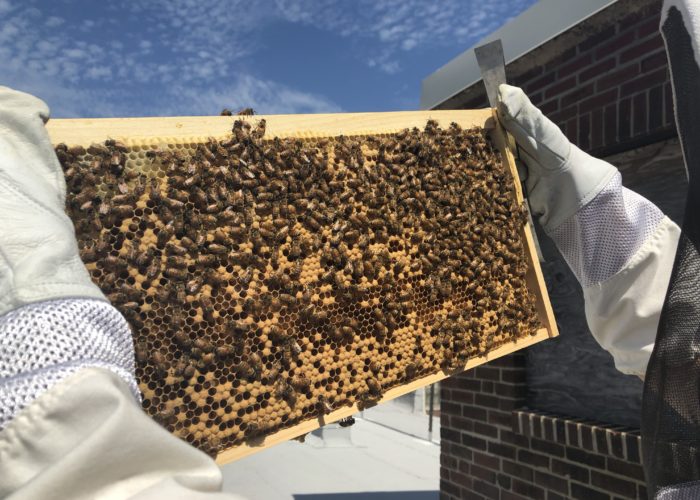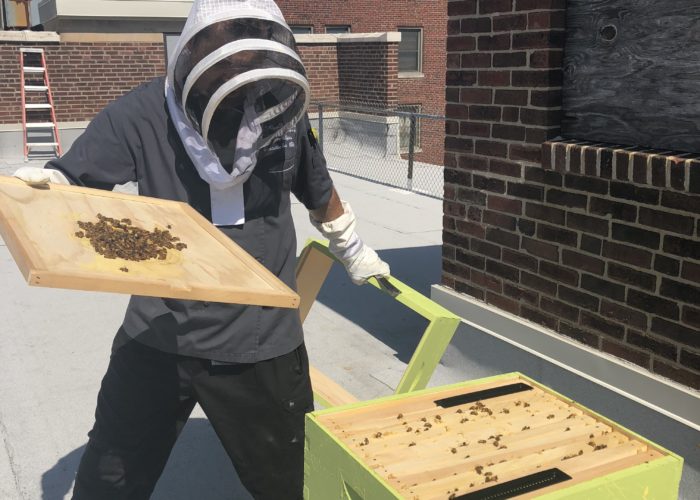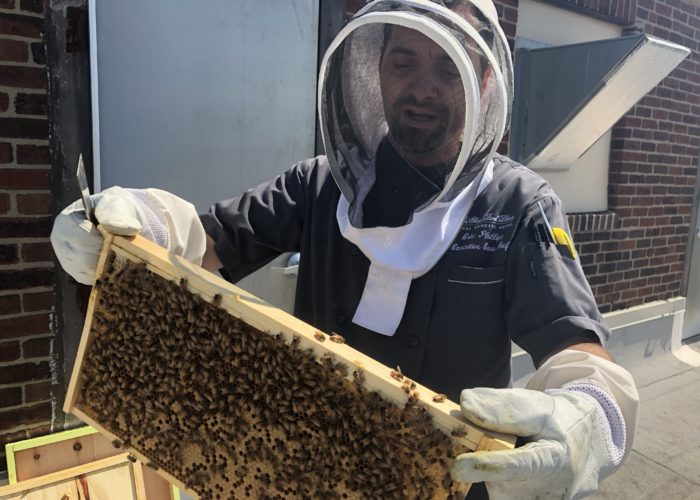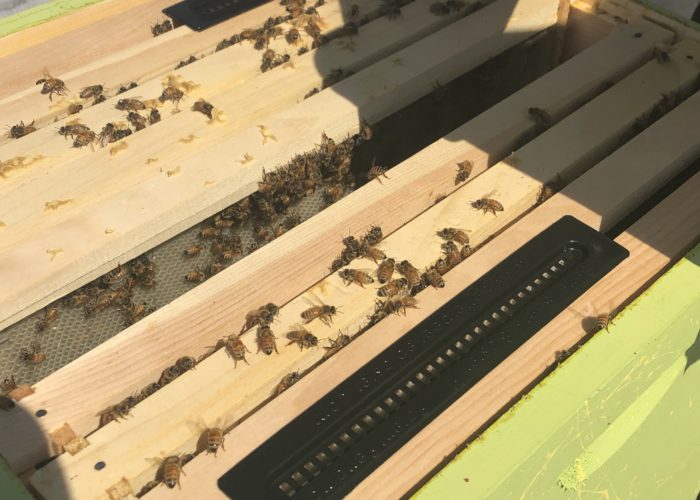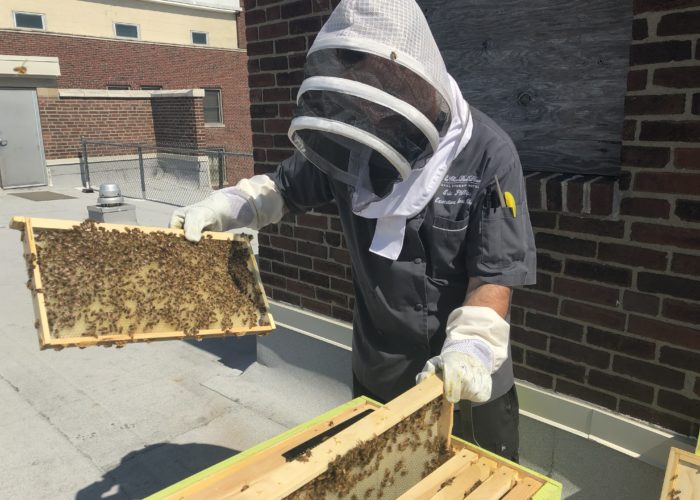The Chase Park Plaza is buzzing with excitement!
The hotel, which is located in the heart of the Central West End, is highly regarded for its historic elegance and luxurious accommodations. It’s home to three unique restaurants, an 18,000 square foot fitness facility, a 5-screen movie theater, and a salon and spa. But that’s not all- The Chase Park Plaza is now home to approximately 30,000 honeybees, and that number continues to grow each day! But don’t worry- you won’t find any bees buzzing around you at the pool. Their housing boxes are up on the roof! We recently sat down with Executive Sous Chef, Eric Phillips, to learn all about this exciting endeavor and when guests can experience “The Chase Park Honey.”
Where did the idea come from to harvest honey at The Chase Park Plaza?
Eric Phillips: I think we’re always looking for interesting ideas inside the culinary world. We started a composting program and we’re moving toward a full-on recycling program. But the bees, that’s something that we always talked about as a group. Our Executive Chef, Gunter Weber, just one day was like “You know I pitched this idea to the Food and Beverage Director and he’s kind of on board.” Another one of our hotel properties has bees also, so we weren’t the first in the company. So there was a little bit of a track record, which made our management kind of buy in. But it was just something fun for us, to one- give back because the honeybees are having that problem where they’re starting to dwindle out. But it was also a way for us to educate ourselves and our cooks. We thought it was really important here for our development and their development to take that chance. And it’s worked out so far. It’s been a lot of fun and a complete learning curve for all of us, because none of us have ever had bees, so we’re excited about the growth that we’re doing.
Was the hotel completely on board from Day 1?
Eric Phillips: You know, there’s always the fear I think people have, of what’s going to happen at the pool… what’s going to happen if the bees start swarming. What we’re doing is nothing like the bees you might find in your backyard, that are kind of just in your face and bothering you. Nobody here has even seen our bees. As soon as we had the idea and it was a little more in motion that it was going to happen, we started looking around at options of where we could put the bees. That was everybody’s concern. Chef Gunter already knew about bees living in this area, on rooftops and doing well. We started walking around all of our rooftops with our engineering crew, figuring out what would be the best option. We kind of settled on the one that we picked, being that it has the most direct access and the most sunlight for the bees. Everybody was really excited about it and they’re excited to see where it goes.
Can you walk us through the harvesting process and what that entails?
Eric Phillips: We’ve been told, not to really expect anything for the first year. The bees are learning their hive, they’re learning their area… so really all the honey that they’ve amassed to this point is for them. Bees are really funny. They literally work themselves to death. So right now, they’re working around the clock, nonstop, for the winter. All the honey that they’re gathering now, is what they’re supposed to live off of throughout the winter. When we go up and we look at some of the frames, we’re seeing all the little patches of honey, but we need them to continue to build all of that for their growth. Once that’s all full and everything looks good, we’ll put what they call a honey super on top. This is a thinner box and all the honey they grow up there is what we’ll be able to take off and use. Whether it’s the wax and the hive… if we wanted to do pieces of the actual honeycomb, we can do that. Or we’ll pull the honey out of those and then leave all the stuff in the housing boxes for them to live off of.
So you currently have 30,000 honeybees up on the roof?
Eric Phillips: 30,000ish. When you buy the hives, they come in tens. The hive that we bought that was a brand-new, unestablished hive is doing really well. We bought one hive that was an established one, that had a queen and some bees in it, but that one had some problems during delivery. Some of the bees didn’t make it, so that hive is sort of struggling a little bit compared to our other hive. The hive that is doing well has already amassed another 6 to 7 thousand bees, so that one’s probably in the 20,000 range. The other hive we’re hoping is back up to its original 10 by now. Obviously, it’s really hard to count, but we probably have around 30,000 if we had to put a number on it now.
With that many bees, how much honey do you hope to harvest?
Eric Phillips: That’s where our learning piece comes in, because we don’t really know. I think it’s sort of a gamble to begin with, because you don’t really know how much they’re going to be able to actually produce, how well they’re working and how much pollen they can get from the area. All of that is going to determine what we can get up there. I think we’re really hoping that we are going to be able to get 4, 5, 6 gallons. That would be awesome. And then our goal is to use that in The Preston for specials, or some of the desserts that our Pastry Chef wants to come up with. We’re also thinking about giving them away in little jars and using them as room amenities for our VIP’s. We’re not really sure how much we’re going to get, we’re just going to be really excited when we can actually get some and bring it down here and start letting people eat it.
So you’re already planning what kind of dishes you’ll be using this honey in?
Eric Phillips: We featured some the other day, just in our thinking processes. I think our Chef de Cuisine, Nathan, did honey-glazed ribs. Our Pastry Chef, Josh, he did a honey mousse with little chocolate pieces that looked like honeycomb. That’s what we’ve done so far. We’re really excited about being able to use it in our amenity program for our VIP guests and our corporate team when they come in. We always try to put something really nice in their rooms. We’re really excited about trying to figure out how we’re going to be able to jar this, and find cool stickers or logos. These pieces are still a little ways away, because right now we’re just trying to figure out how to keep our hives alive and continuing to grow like they are.
What do you see as the benefit of harvesting your own honey?
Eric Phillips: I think the flavor profile is going to be really cool. And being able to sort of keep with the whole farm-to-table idea and the small plate idea, which is what The Preston is all about. Also, being able to say “This is what the Central West End tastes like” is one thing. I think the other thing is, we’re super excited just how much we learn everyday. When we go up there and we pull the frames out, we see new stuff. We’re learning how to see all the larva in it, and what the honey looks like versus what the nectar is, and that whole process to us has been fascinating. I think as chefs, we’re always trying to further ourselves… to want to do better. It’s been a lot of fun. We’re really excited about being able to bring Chase Park honey to our guests.
Will you continue harvesting honey after this year?
Eric Phillips: We’re optimistic that our bees are going to do well. We’ve already talked about buying a third hive and ordering it so that it will be here next spring. So as soon as spring rolls around, we’ll have the two established hives, that will be able to get right to work and start making honey for us. And then we’ll have another hive that will be in this stage, that we can grow and move along. So then by two years, we’ll be able to have three hives that are producing nothing but honey for us. That’s definitely the plan.
